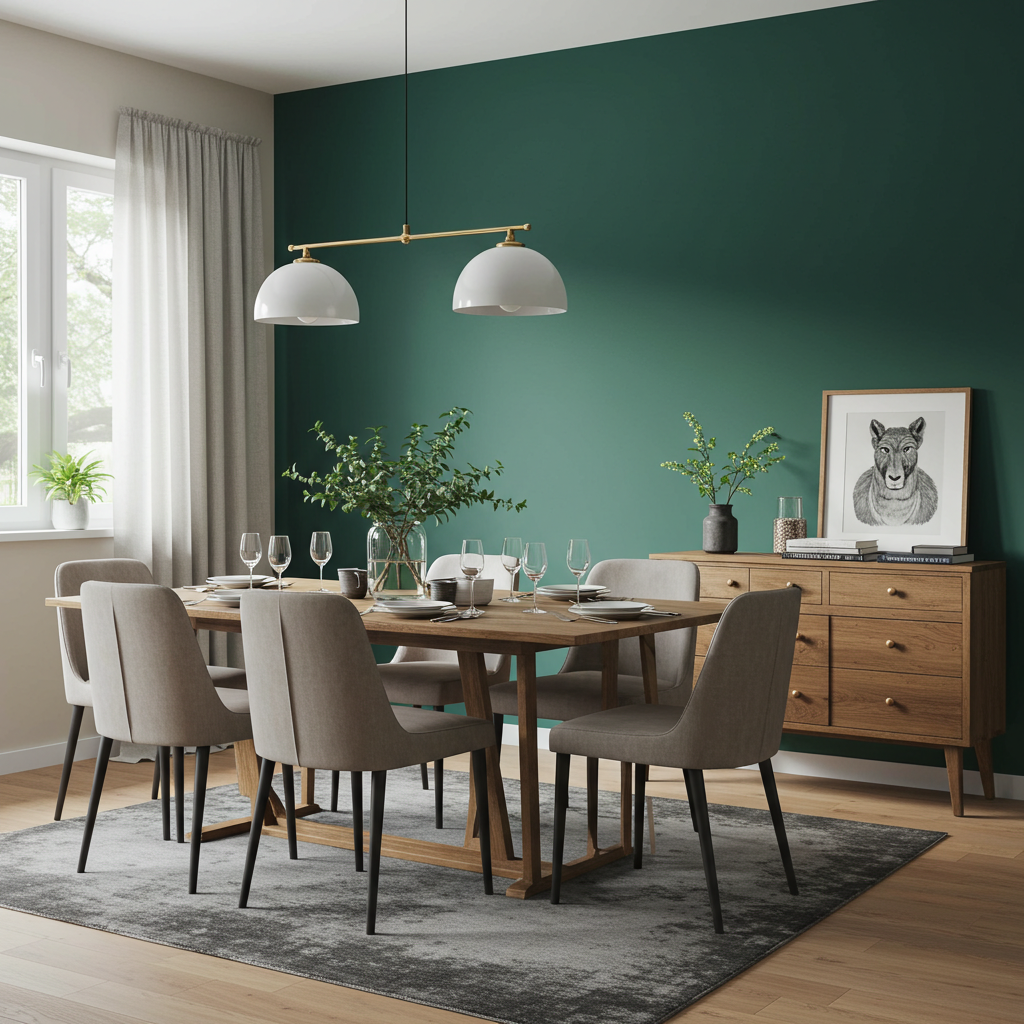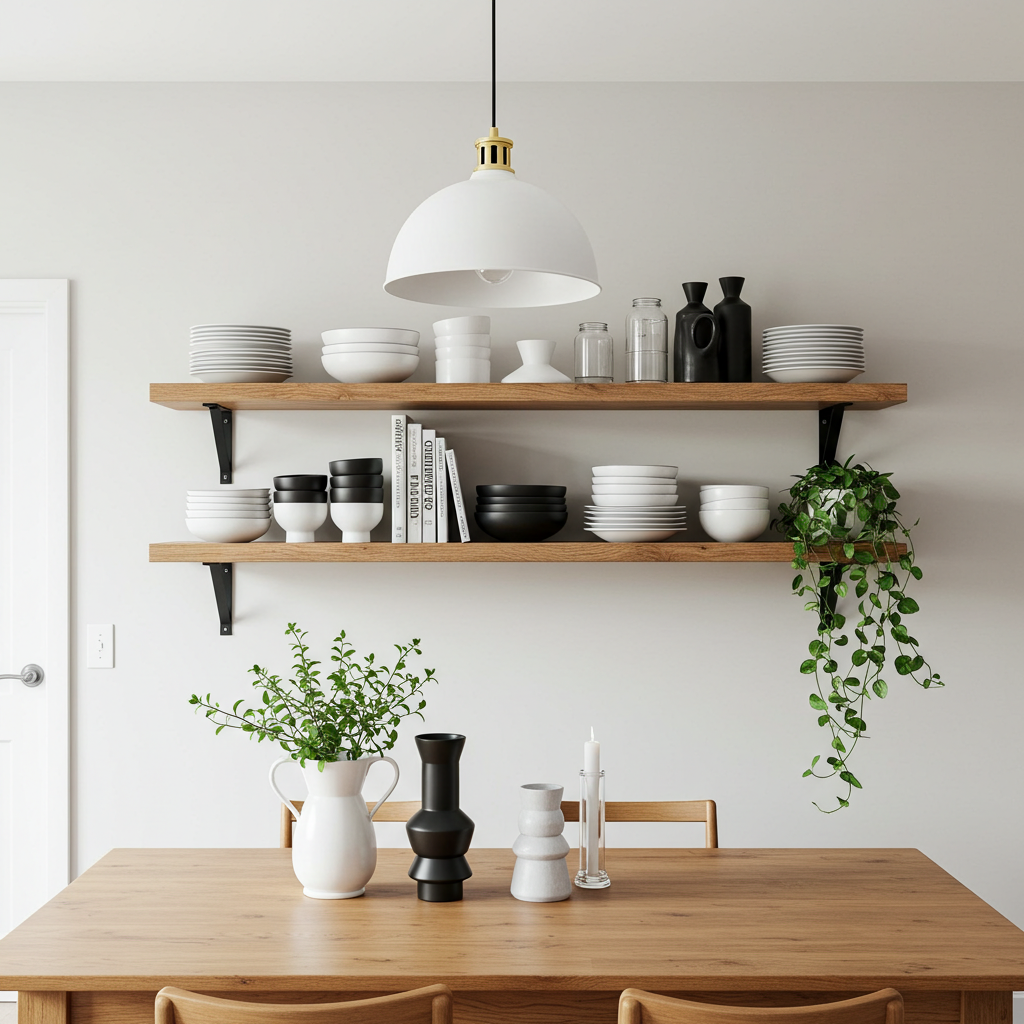Your dining room is more than just a place to eat—it’s a hub for connection, creativity, and comfort. Whether you’re hosting lively dinners or enjoying quiet morning coffee, the right design can elevate every moment. Below, we’ve curated 24 simple dining room design ideas that blend functionality with style, perfect for homeowners craving a fresh yet achievable update. From budget-friendly tweaks to statement-making focal points, these tips cater to modern aesthetics and timeless charm.
1. Mix Modern and Vintage Furniture
Blending eras adds instant character to your dining area. Try pairing a sleek, contemporary table with rustic wooden chairs or vice versa. The contrast creates visual intrigue while keeping the space feeling curated rather than cluttered. For example, a mid-century modern credenza can anchor a room adorned with industrial pendant lights. Balance is key: stick to a cohesive color palette to unify disparate styles. Add texture with linen napkins or a vintage rug to soften sharp lines.
2. Layer Lighting for Ambiance
Overhead fixtures alone can leave your dining room feeling flat. Incorporate layered lighting by combining a statement chandelier with wall sconces, table lamps, or even candlelight. Dimmable options let you adjust brightness for intimate dinners or festive gatherings. For a modern twist, opt for geometric pendant lights above the table, then flank a sideboard with warm, brass-toned lamps. This approach adds depth and highlights architectural features or artwork.
3. Experiment with Bold Wall Treatments
A bold accent wall can redefine your dining room without a full renovation. Consider removable wallpaper in dramatic patterns like tropical botanicals or abstract metallics. Alternatively, try paint techniques like color-blocking or a matte-black finish for a moody, sophisticated vibe. If commitment worries you, lean into large-scale art or a gallery wall to inject personality. Just ensure the colors complement your tableware and furnishings for harmony.
4. Opt for Multifunctional Furniture
Small spaces thrive on versatility. Choose an extendable dining table that adapts to guest counts, or benches with hidden storage for linens and serveware. A bar cart doubles as a drink station and decorative display, while mirrored consoles can visually expand tight areas. For open-concept homes, use a room divider like a bookshelf to subtly separate the dining zone without blocking light.
5. Play with Textured Table Settings
Your tabletop is a canvas for creativity. Layer woven placemats under ceramic dinnerware, add linen napkins tied with velvet ribbons, or mix metallic flatware for a luxe touch. Seasonal centerpieces—think dried florals in autumn or citrus fruits in summer—keep the look dynamic. For everyday elegance, invest in stoneware plates and textured glassware that feel special yet durable.
6. Incorporate Natural Elements
Bring the outdoors in with organic materials like wood, stone, or rattan. A live-edge wooden table becomes a striking focal point, while potted plants like fiddle-leaf figs or trailing pothos add life. Jute rugs, bamboo blinds, or a woven pendant light reinforce the earthy vibe. Pair these with neutral tones like sage green or terracotta to amplify the calming, nature-inspired aesthetic.
7. Refresh with Statement Chair Covers
Swap outdated dining chairs without buying new ones. Slipcovers in bold prints or rich fabrics like velvet can instantly modernize your setup. For a cohesive look, match the cover color to accents in your room—think navy cushions to echo artwork or blush tones for a soft contrast against dark walls. Alternatively, paint existing chairs in a high-gloss hue for a budget-friendly update.
8. Add a Mirror to Enhance Space
Mirrors aren’t just for bedrooms—they’re a dining room game-changer. Position a large mirror opposite a window to reflect natural light and create the illusion of a bigger room. Opt for ornate frames to evoke vintage glamour or sleek, frameless designs for modern minimalism. For small spaces, lean a floor mirror against a wall to add depth without permanent installation. Pair it with metallic accents like brass candleholders or silver vases to amplify the reflective effect.
9. Choose a Cohesive Color Palette
Stick to 2–3 primary colors to unify your dining room’s look. Soft neutrals like beige, gray, or cream create a calming base, while bold hues like emerald green or navy blue add drama. For a playful twist, paint your ceiling a contrasting shade or use colored trim on chairs. Extend the palette to table linens, artwork, and dishware for a polished, intentional vibe. Remember, muted tones keep the space serene, while saturated colors energize gatherings.
10. Install Open Shelving for Display
Replace bulky cabinets with open shelves to showcase stylish serveware, cookbooks, or heirloom pieces. Floating wooden shelves add warmth, while black iron brackets give an industrial edge. Style shelves asymmetrically—layer stacks of plates with trailing plants or sculptural ceramics. This not only saves space but also encourages you to declutter and curate a visually appealing collection. Bonus: It’s perfect for easy access during dinner parties!
11. Anchor the Room with an Area Rug
Define your dining zone with a rug that complements your table’s shape and size. For round tables, try a circular rug; rectangular tables pair well with oversized linear designs. Low-pile rugs (like wool or jute) are durable and easy to clean. Patterns hide crumbs, while solid colors let bold furniture shine. Ensure the rug extends at least 24 inches beyond the table edges to prevent chairs from catching on the fringe.
12. Update Hardware for a Quick Refresh
Swap outdated cabinet knobs, drawer pulls, or light fixtures for instant modern flair. Matte black or brass hardware elevates plain furniture, while crystal knobs add vintage charm. Match finishes to other elements in the room—for example, bronze handles tie into a rattan chandelier. Even small changes, like replacing hinge covers or outlet plates, can make cabinetry and walls look intentional and polished.
13. Create a Statement Ceiling
Don’t neglect the “fifth wall”! Paint your ceiling a moody hue like charcoal or deep teal for intimacy, or use wallpaper with subtle patterns for texture. Wooden beams or tin tiles add rustic or Victorian character, respectively. For renters, temporary peel-and-stick decals or removable medallions around light fixtures offer a non-commitment upgrade. Pair with minimalist furniture to keep the focus overhead.
14. Embrace Seasonal Decor Swaps
Keep your dining room feeling fresh year-round with rotating accents. In spring, add pastel table runners and fresh tulips; in winter, layer faux fur throws and metallic candleholders. Store seasonal items in labeled bins for easy swaps. A simple centerpiece—like a bowl of pinecones in fall or seashells in summer—adds thematic charm without overwhelming the space.
15. Go Minimalist with Clean Lines
Less is more in compact dining rooms. Choose a streamlined table with tapered legs, paired with monochromatic chairs. Keep walls bare or hang a single oversized artwork for focus. Built-in banquettes maximize seating without crowding the floor. Stick to a neutral palette with one accent color (e.g., mustard pillows or a slate-blue vase) to maintain airiness. This approach feels modern, uncluttered, and timeless.
16. Incorporate Kid-Friendly Elements
Family-friendly design doesn’t sacrifice style. Use wipeable vinyl chair cushions in fun prints, or opt for stain-resistant performance fabrics on upholstered seats. Store kids’ art supplies in a chic sideboard or hang their masterpieces in matching frames for a playful gallery wall. Round table corners prevent bumps, and durable materials like quartz or laminate mimic marble without the maintenance.
17. Add Drama with Window Treatments
Elevate plain windows with floor-length curtains in luxe fabrics like velvet or linen. Bold patterns (stripes, florals) make windows a focal point, while sheer panels soften harsh light. For a modern look, install curtain rods closer to the ceiling to heighten the room. Match drapery ties to your table linens, or use tasseled ropes for bohemian flair. Don’t forget blackout shades for movie-night dinners!
18. Style a Bar Cart as Functional Decor
A rolling bar cart serves drinks and style. Stock it with decanters, glassware, and a small tray for garnishes. Decorate with a mini vase, coffee table books, or a succulent for personality. Position it near the dining table for easy access during gatherings. For small spaces, choose a narrow, tiered cart that fits snugly against a wall or in a corner.
19. Mix Chair Styles for Eclectic Vibes
Who says all chairs need to match? Combine upholstered host chairs with wooden benches or acrylic side seats. Stick to a common element—like matching wood tones or uniform seat heights—to avoid chaos. For example, pair black Windsor chairs with a white bench, or mix cane-backed chairs with metallic stools. This approach adds visual interest and accommodates diverse guest preferences.
20. Use Upholstered Benches for Comfort
Swap chairs for plush benches along one side of the table. They’re space-efficient, perfect for squeezing in extra guests, and ideal for casual meals. Choose bench cushions in performance fabric for spills, or go bold with velvet for luxury. Tuck baskets underneath for storing throws or tablecloths. Pair with contrasting chairs on the opposite side to balance the look.
21. Try a Monochromatic Scheme
Pick one color and explore its shades for a sophisticated, cohesive look. For example, pair slate-gray walls with charcoal chairs, a dove-gray rug, and silver tableware. Add depth with varying textures—glossy ceramics, nubby linens, and smooth marble. Introduce subtle contrast via metallic accents (e.g., gold cutlery or a bronze vase) to keep the palette from feeling flat.
22. DIY a Statement Light Fixture
Personalize your lighting with a DIY project. Wrap a basic pendant with rattan for a coastal vibe, or drape a chandelier with beads for boho flair. String Edison bulbs above the table for industrial charm, or repurpose vintage colanders into quirky pendant shades. Tutorials abound online—choose a style that complements your dining room’s aesthetic and your skill level.
23. Incorporate Mixed Metals
Combine brass, chrome, and copper for layered elegance. A brass chandelier, chrome chair legs, and copper vase create balance without matchy-matchy rigidity. Stick to 2–3 metals to avoid overwhelm, and repeat each finish in small doses (e.g., drawer pulls, picture frames, or candleholders). This adds richness and works well in both modern and traditional spaces.
24. Create an Eclectic Centerpiece
Ditch predictable flower arrangements. Try stacked hardcover books with a sculptural object on top, a trio of mismatched vintage bottles, or a wooden bowl filled with fruit. For holidays, weave in themed elements like mini pumpkins or fairy lights. Rotate pieces seasonally to keep the table looking dynamic. Ensure the centerpiece is low enough to allow easy conversation across the table.

























